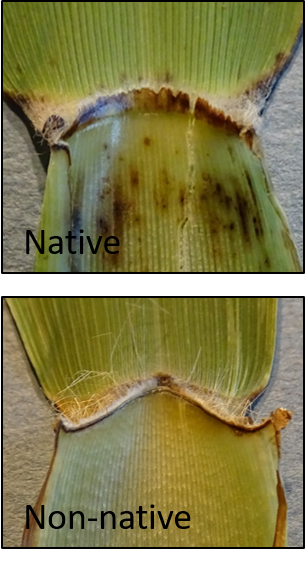Distinguishing invasive, non-native Phragmites australis from its native subspecies can be challenging. Here we provide guidance to assist you in making this distinction. The morphological characters described here are presented in order from stronger to weaker characters. Reliable ID requires using 3-4 different characters.
- Characters most readily identifiable in the field are leaf sheath adherence to the stem, stem color, and stem glossiness. These characters are best used after mid-summer and in winter.
- Ligule height can be a strong character but using it in the field requires a little bit of practice.
- Stand density, stem height, leaf color, and inflorescences are variable characters that are not reliable on their own for identification but can be used to help flag potentially invasive populations for further investigation.
Report populations of suspected non-native Phragmites in the EDDMapS Pro app. Your report should include several photos. Include an image of the whole stand, as well as details of the leaf sheaths, stem color/texture, a close-up of the ligule, and inflorescences.
The locations of known native Phragmites populations can be found on our map of verified Phragmites populations in Minnesota.
Grass vegetative structures


Leaf adherence to stem
In early to mid summer, the leaf sheaths on the upper stems of native Phragmites are also tightly adhering. Lower sheaths may be somewhat loose, but may not gap yet. Note that the sheaths of native Phragmites, particularly on the lower stems, do not consistently overlap each other and the stem is exposed in the gap between the two adjacent sheaths. In early summer, the stems will already be red where they are not covered by the sheath and they will be smooth and shiny.
The sheaths of non-native Phragmites more consistently overlap each other, so the stem appears to be more consistently green. Sometimes on the lower stem, the sheaths do not overlap, and where the stem is exposed, it may have a reddish blush. This seems to be more typical of young stems and stems growing in standing water. Where the stem is exposed, it will be dull and rough, as described below.

Stem texture and color


Ligule height (thickness)
Ligule height (thickness) is one of the stronger characters for identifying non-native Phragmites. Although it may not be easy to measure in the field, it can be visually determined with a little practice using the cues described here.
Measure ligule height on leaves from approximately the middle third of the plant. Ligules on upper, newly emerging leaves are not as well-developed. On lower leaves, ligules may be degraded


Stem density, persistence, and height

Leaf blade color

Inflorescence
The large fluffy inflorescences along with the height of the plants may be the first thing that draw your attention to Phragmites. Don’t rely on these characteristics alone to make an ID. Confirm the ID using characteristics of the sheath, stem texture, stem color, and ligule.

Late winter and early summer ID tips


Difficult/less reliable characteristics

Characteristics used to distinguish between native and non-native Phragmites are summarized in the table below, with lighter-colored backgrounds indicating stronger indicators. The characteristics with the darkest background are not reliable on their own for identification. A solid ID depends on using 3-4 different characters.

1 Leaf sheath and stem glossiness are best used after mid-summer and in winter.
2 Measure ligule height on leaves from approximately the middle third of the plant. Ligules on upper, newly emerging leaves are not as well-developed. On lower leaves, ligules may be degraded.
3 For stem color and texture, be sure to assess the stem and not the leaf sheath which covers the stem.
4 The height of the plants along with the large fluffy inflorescences may be the first thing that draws your attention to Phragmites. Don’t rely on these characteristics alone to make an ID.
